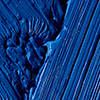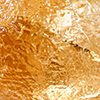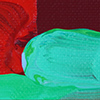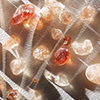Traditional Gesso Recipe
Ingredients
80 gm Rabbit Skin Glue
1100 ml Water
450 gm Calcium Carbonate (Gilders Whiting)
50 gm Titanium White pigment
Process
Take 80gm of Rabbit Skin Glue and add 1.1 Litres of water.
Leave to swell for approximately 2 hours until it is a uniform beige colour. Keep the lid on this solution.
Melt the glue in a double boiler and leave to set in a cool place.
Test it at room temperature, otherwise it may appear stronger than it really is.
The set glue should look and feel like fruit jelly except a split in it with your finger should be firm and rough rather than smooth and tough. If the jelly is too strong add more water.
Gesso should be applied to non-flexible supports such as boards, not stretched canvas, as this will flex too much and the gesso will crack. Size the board with the Rabbit Skin Glue Size that has been diluted with water by 50%.
Sizing helps reduce absorbency of the surface.
Warm the size till it is hot (Do not boil!) and apply to the board sparingly.
Size one side and the edges first and leave the board to dry flat.
Once dry enough to turn over, size the other side and leave to dry thoroughly, between 3-12 hours.
Gesso needs to be white in order for the painting to be as bright as possible.
Use Gilders Whiting as it has good dispersion in the glue size, dries to a fairly white finish and is relatively cheap.
Replacing 10% of the Whiting with Titanium White pigment will improve the brightness & opacity of the gesso without affecting structure. Start with approx. 450 gm of whiting and 50 gm of Titanium pigment and mix whilst dry.
This quantity of chalk/pigment and the earlier quantities of Glue Size will make enough gesso for 3-4 coats on a 150cm x 125cm board. Heat the glue until it is hot.
Transfer the glue into a spare pan and put the pigment mixture in the double boiler, keeping the boiler on the lowest heat possible.
Pour enough glue into the mixed pigment to stir into a lump free paste. Make sure the pigment is thoroughly wet and mixed.
Keep the lid on the mixture from now on or the gesso will thicken up and skin over from water evaporation.
Gesso is built up in layers, usually five, not less than three, to obtain a structure of decent thickness.
Several thin layers are more stable than one thick one.
Make gesso in the morning so you can complete boards in one day as pin holes can develop if new gesso is applied over a fully dry coat. If the gesso thickens during the day because of evaporation of water add a little hot water (not glue) to keep it a thin cream consistency. Otherwise the glue, and hence the gesso, will become too strong. It is important to keep the gesso the same strength because stronger layers over weaker ones will cause them to crack and pull off the board.
Stir very gently the gesso just before each application to prevent the pigment from settling to the bottom of the pan.
Try not to whip in air bubbles as this can create pin holes.
Brush on the first layer gently (not too vigorously) including the edges.
Wash the brush out in between layers or it will set hard before using for the next coat.
The gesso will be dry to touch in 10-20 minutes.
Build the layers up one by one, including the edges. Drying time get a bit longer as more layers applied .
Brush the third and subsequent layers at right angles to the previous coat.
This helps to produce a level gesso ground.
Keep applying until the gesso is 1-2 mm thick or more, so that the dry gesso is thick enough to sand.
Leave to dry thoroughly, between 12-24 hours
Disclaimer
The above information is based on research and testing done by Langridge Artist Colours Pty Ltd and is provided as a basis for understand- ing the potential uses of the product mentioned. Due to the numerous variables in methods, materials and conditions of producing art, Langridge Artist Colours Pty Ltd cannot be sure the product will be the correct for the artists intended use. Therefore, we urge product users to test each application to ensure all individual requirements are met. While we believe the above information is correct, We make no express or Implied Warranties of Merchantability or Fitness for a particular purpose. Langridge shall in no event be liable for any damages (indirect, consequential or otherwise) that may occur as a result of a product application




